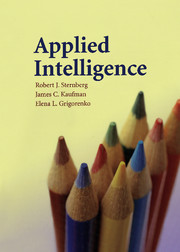Book contents
- Frontmatter
- Contents
- Preface
- 1 Views of Intelligence
- 2 The Theory of Successful Human Intelligence
- 3 Metacognition: Thinking with Metacomponents
- 4 Advanced Problem-Solving Steps
- 5 Cognitive Processing: Performance Components (I)
- 6 Cognitive Processing: Performance Components (II)
- 7 Logical Reasoning and Analysis of Arguments: Performance Components (III)
- 8 Inference and Inferential Fallacies
- 9 Knowledge-Acquisition Components
- 10 Coping with Novelty
- 11 Deciding for Creativity
- 12 Automatizing Information Processing
- 13 Practical Intelligence
- 14 Why Intelligent People Fail (Too Often)
- References
- Author Index
- Subject Index
11 - Deciding for Creativity
Published online by Cambridge University Press: 09 November 2009
- Frontmatter
- Contents
- Preface
- 1 Views of Intelligence
- 2 The Theory of Successful Human Intelligence
- 3 Metacognition: Thinking with Metacomponents
- 4 Advanced Problem-Solving Steps
- 5 Cognitive Processing: Performance Components (I)
- 6 Cognitive Processing: Performance Components (II)
- 7 Logical Reasoning and Analysis of Arguments: Performance Components (III)
- 8 Inference and Inferential Fallacies
- 9 Knowledge-Acquisition Components
- 10 Coping with Novelty
- 11 Deciding for Creativity
- 12 Automatizing Information Processing
- 13 Practical Intelligence
- 14 Why Intelligent People Fail (Too Often)
- References
- Author Index
- Subject Index
Summary
Creativity is another aspect of dealing with novelty. What is creativity? Your first thought may be that it is something different – “thinking outside of the box.” Certainly, this is an important part of creativity. But psychologists view creativity as being a little more complex than just being something new. Creativity is traditionally defined as something that is novel, good, and appropriate for the task. If you are asked a math question on a midterm and you draw a picture of an elephant, then this is doing something in a different way but not necessarily a creative way (Kaufman & Sternberg, 2007). Research suggests that, to a large extent, people can become creative if they decide that is what they want to do (Chen, Kasof, Himsel, Dmitrieva, Dong, & Xue, 2005).
Creativity can occur anywhere. Consider, for example, the following story: A politician and his wife decide to eat dinner in a fancy French restaurant in Washington, DC. The waiter approaches their table and asks the wife what she would like as an appetizer. “The garlic bread,” she tells the waiter. “And the main course?” the waiter asks. “The steak,” responds the politician's wife. “And the vegetable?” asks the waiter. “He'll have the same,” responds the politician's wife.
Some people think that only the “greats” can be creative – the Darwins, the Mozarts, the Picassos, the Shakespeares. But we do not believe that this is true. Instead, creativity is a decision that anyone can make.
- Type
- Chapter
- Information
- Applied Intelligence , pp. 291 - 304Publisher: Cambridge University PressPrint publication year: 2008



